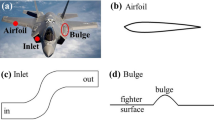Abstract
In this paper, Runge-kutta exponential time differencing (RKETD) method for dispersive media is introduced. The high accuracy and efficiency of this method is verified by calculating the reflection and transmission coefficients for a non-magnetized collisional plasma slab. The stealth effect of radar targets covered with Epstein distribution inhomogeneous non-magnetized plasma is studied. The results show that the stealth effect of radar targets covered with Epstein distribution inhomogeneous plasma is better than that of radar targets covered with homogeneous non-magnetized plasma.




Similar content being viewed by others
References
R. J. Luebbers, F. Hunsberger, K. S. Kunz, R. Standler, and M. Schneier, “A frequency-dependent finite-difference time-domain formulation for transient propagation in plasma,” IEEE Transactions on Antennas and Propagation, vol. 39, no. 1, pp. 29–34, January 1991.
J. L. Young, “Propagation in linear dispersive media: Finite difference time-domain methodologies,” IEEE Transactions on Antennas and Propagation, vol. 43, no. 3, pp. 422–426, 1995.
D. M. Sullivan, “Frequency-dependent FDTD methods using Z transforms,” IEEE Transactions on Antennas and Propagation, vol. 40, pp. 1223–1230, 1992.
D. F. Kelley and R. J. Luebbers, “Piecewise linear recursive convolution for dispersive media using FDTD,” IEEE Transactions on Antennas and Propagation, vol. 44, pp. 792–797, 1996.
S. Lin, N. Yuan, and J. Mo, “A novel FDTD formulation for dispersive media,” IEEE Microwave and Wireless Components Letters, vol. 13, no. 5, pp. 187–189, May 2003.
S. Lin, J. Mo, and N. Yuan, “Piecewise linear current density recursive convolution FDTD implementation for anisotropic magnetized plasmas,” IEEE Microwave and Wireless Components Letters, vol. 14, pp. 222–224, 2004.
S. Lin, J. Mo, and N. Yuan, “A nove FDTD simulation for plasma piecewise linear current density recursive convolution” Acta Physica Sinica, vol. 53, no. 3, pp. 778–782, March 2004.
H. W. Yang, R. S. Chen, and Y. Zhang. “SO-FDTD method and its application to the calculation of electromagnetic wave reflection coefficients of plasma” Acta Physica Sinica, vol. 55, no. 7, pp. 3465–3469, July 2006.
D. B. Ge, Y. L. Wu, and X. Q. Zhu, “Shift operator method applied for dispersive medium in FDTD analysis,” Journal of Radio Science, vol. 18, no. 4, pp. 359–362, August 2003.
Hong Wei Yang,“A FDTD Analysis on Magnetized Plasma of Epstein Distribution and Reflection Calculation,” Computer Physics Communications,Vol.180,No.1,pp.55–60,January 2009.
S. M. Cox and P. C. Matthews, “Exponential time differencing for stiff systems,” Journal of Computational Physics, vol. 176, no. 2, pp. 430–455, March 2002.
Sh. J. Huang, “Exponential time differencing FDTD formulation for plasma,” Microwave and Optical Technology Letters, vol. 49, no. 6, pp. 1363–1364, June 2007.
S. Liu, S. Zhong and S. Liu, “Finite-difference time-domain algorithm for dispersive media based on Runge-Kutta exponential time differencing method,” Int J Infrared Milli Waves, vol. 29, pp. 323–328, 2008.
Author information
Authors and Affiliations
Corresponding author
Rights and permissions
About this article
Cite this article
Yang, H.W., Liu, Y. Runge-kutta Exponential Time Differencing Method Analysis of Non-magnetized Plasma Stealth. J Infrared Milli Terahz Waves 31, 1075–1080 (2010). https://doi.org/10.1007/s10762-010-9680-6
Received:
Accepted:
Published:
Issue Date:
DOI: https://doi.org/10.1007/s10762-010-9680-6




